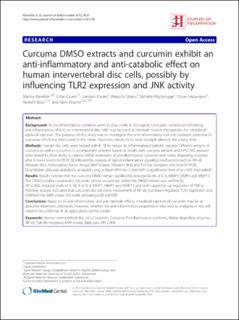Please use this identifier to cite or link to this item:
https://doi.org/10.21256/zhaw-4871Full metadata record
| DC Field | Value | Language |
|---|---|---|
| dc.contributor.author | Klawitter, Marina | - |
| dc.contributor.author | Quero, Lilian | - |
| dc.contributor.author | Klasen, Juergen | - |
| dc.contributor.author | Gloess, Alexia N. | - |
| dc.contributor.author | Klopprogge, Babette | - |
| dc.contributor.author | Hausmann, Oliver | - |
| dc.contributor.author | Boos, Norbert | - |
| dc.contributor.author | Wuertz, Karin | - |
| dc.date.accessioned | 2018-11-16T10:08:48Z | - |
| dc.date.available | 2018-11-16T10:08:48Z | - |
| dc.date.issued | 2012 | - |
| dc.identifier.issn | 1476-9255 | de_CH |
| dc.identifier.uri | https://digitalcollection.zhaw.ch/handle/11475/12905 | - |
| dc.description.abstract | Background: As proinflammatory cytokines seem to play a role in discogenic back pain, substances exhibiting anti-inflammatory effects on intervertebral disc cells may be used as minimal-invasive therapeutics for intradiscal/epidural injection. The purpose of this study was to investigate the anti-inflammatory and anti-catabolic potential of curcuma, which has been used in the Indian Ayurvedic medicine to treat multiple ailments for a long time. Methods: Human disc cells were treated with IL-1β to induce an inflammatory/catabolic cascade. Different extracts of curcuma as well as curcumin (= a component selected based on results with curcuma extracts and HPLC/MS analysis) were tested for their ability to reduce mRNA expression of proinflammatory cytokines and matrix degrading enzymes after 6 hours (real-time RT-PCR), followed by analysis of typical inflammatory signaling mechanisms such as NF-κB (Western Blot, Transcription Factor Assay), MAP kinases (Western Blot) and Toll-like receptors (real-time RT-PCR). Quantitative data was statistically analyzed using a Mann Whitney U test with a significance level of p < 0.05 (two-tailed). Results: Results indicate that the curcuma DMSO extract significantly reduced levels of IL-6, MMP1, MMP3 and MMP13. The DMSO-soluble component curcumin, whose occurrence within the DMSO extract was verified by HPLC/MS, reduced levels of IL-1β, IL-6, IL-8, MMP1, MMP3 and MMP13 and both caused an up-regulation of TNF-α. Pathway analysis indicated that curcumin did not show involvement of NF-κB, but down-regulated TLR2 expression and inhibited the MAP kinase JNK while activating p38 and ERK. Conclusions: Based on its anti-inflammatory and anti-catabolic effects, intradiscal injection of curcumin may be an attractive treatment alternative. However, whether the anti-inflammatory properties in vitro lead to analgesia in vivo will need to be confirmed in an appropriate animal model. | de_CH |
| dc.language.iso | en | de_CH |
| dc.publisher | BioMed Central | de_CH |
| dc.relation.ispartof | Journal of Inflammation | de_CH |
| dc.rights | http://creativecommons.org/licenses/by/2.0/ | de_CH |
| dc.subject.ddc | 580: Pflanzen (Botanik) | de_CH |
| dc.subject.ddc | 610: Medizin und Gesundheit | de_CH |
| dc.title | Curcuma DMSO extracts and curcumin exhibit an anti-inflammatory and anti-catabolic effect on human intervertebral disc cells, possibly by influencing TLR2 expression and JNK activity | de_CH |
| dc.type | Beitrag in wissenschaftlicher Zeitschrift | de_CH |
| dcterms.type | Text | de_CH |
| zhaw.departement | Life Sciences und Facility Management | de_CH |
| zhaw.organisationalunit | Institut für Chemie und Biotechnologie (ICBT) | de_CH |
| dc.identifier.doi | 10.21256/zhaw-4871 | - |
| dc.identifier.doi | 10.1186/1476-9255-9-29 | de_CH |
| dc.identifier.pmid | 22909087 | de_CH |
| zhaw.funding.eu | No | de_CH |
| zhaw.issue | 29 | de_CH |
| zhaw.originated.zhaw | Yes | de_CH |
| zhaw.publication.status | publishedVersion | de_CH |
| zhaw.volume | 9 | de_CH |
| zhaw.publication.review | Peer review (Publikation) | de_CH |
| Appears in collections: | Publikationen Life Sciences und Facility Management | |
Files in This Item:
| File | Description | Size | Format | |
|---|---|---|---|---|
| Klawitter2012_Article_CurcumaDMSOExtractsAndCurcumin.pdf | 1.31 MB | Adobe PDF |  View/Open |
Show simple item record
Klawitter, M., Quero, L., Klasen, J., Gloess, A. N., Klopprogge, B., Hausmann, O., Boos, N., & Wuertz, K. (2012). Curcuma DMSO extracts and curcumin exhibit an anti-inflammatory and anti-catabolic effect on human intervertebral disc cells, possibly by influencing TLR2 expression and JNK activity. Journal of Inflammation, 9(29). https://doi.org/10.21256/zhaw-4871
Klawitter, M. et al. (2012) ‘Curcuma DMSO extracts and curcumin exhibit an anti-inflammatory and anti-catabolic effect on human intervertebral disc cells, possibly by influencing TLR2 expression and JNK activity’, Journal of Inflammation, 9(29). Available at: https://doi.org/10.21256/zhaw-4871.
M. Klawitter et al., “Curcuma DMSO extracts and curcumin exhibit an anti-inflammatory and anti-catabolic effect on human intervertebral disc cells, possibly by influencing TLR2 expression and JNK activity,” Journal of Inflammation, vol. 9, no. 29, 2012, doi: 10.21256/zhaw-4871.
KLAWITTER, Marina, Lilian QUERO, Juergen KLASEN, Alexia N. GLOESS, Babette KLOPPROGGE, Oliver HAUSMANN, Norbert BOOS und Karin WUERTZ, 2012. Curcuma DMSO extracts and curcumin exhibit an anti-inflammatory and anti-catabolic effect on human intervertebral disc cells, possibly by influencing TLR2 expression and JNK activity. Journal of Inflammation. 2012. Bd. 9, Nr. 29. DOI 10.21256/zhaw-4871
Klawitter, Marina, Lilian Quero, Juergen Klasen, Alexia N. Gloess, Babette Klopprogge, Oliver Hausmann, Norbert Boos, and Karin Wuertz. 2012. “Curcuma DMSO Extracts and Curcumin Exhibit an Anti-Inflammatory and Anti-Catabolic Effect on Human Intervertebral Disc Cells, Possibly by Influencing TLR2 Expression and JNK Activity.” Journal of Inflammation 9 (29). https://doi.org/10.21256/zhaw-4871.
Klawitter, Marina, et al. “Curcuma DMSO Extracts and Curcumin Exhibit an Anti-Inflammatory and Anti-Catabolic Effect on Human Intervertebral Disc Cells, Possibly by Influencing TLR2 Expression and JNK Activity.” Journal of Inflammation, vol. 9, no. 29, 2012, https://doi.org/10.21256/zhaw-4871.
Items in DSpace are protected by copyright, with all rights reserved, unless otherwise indicated.